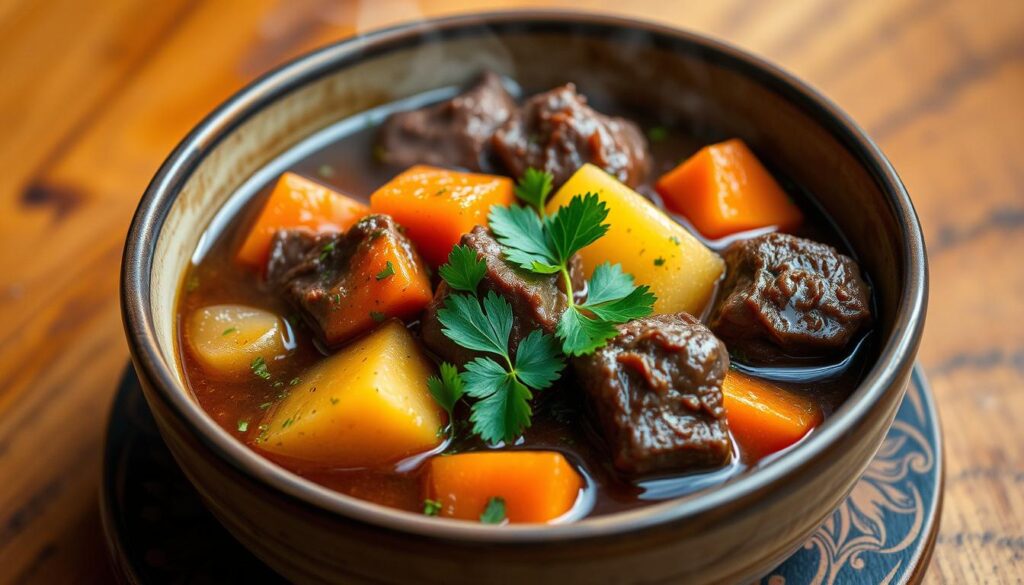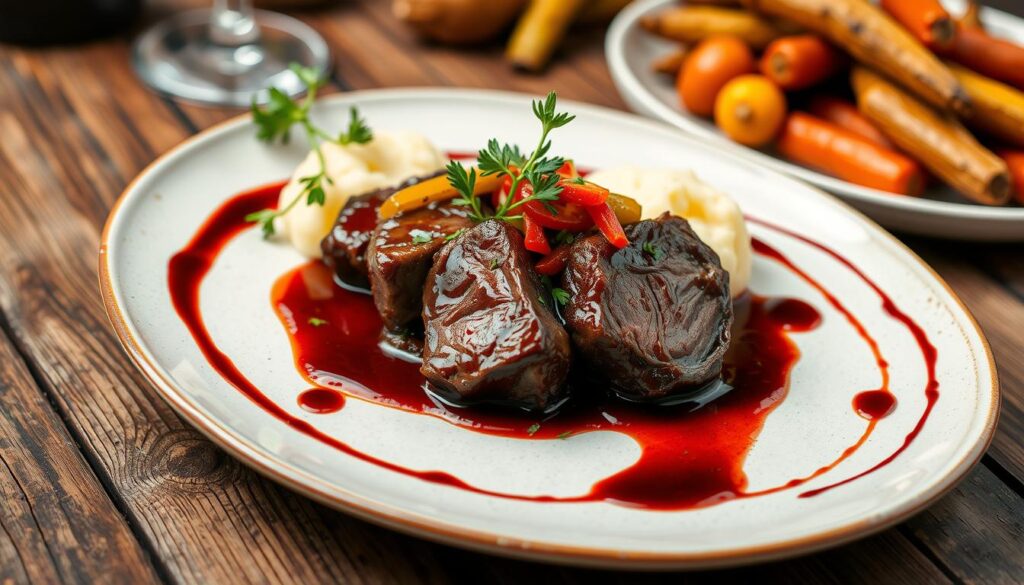Table of Contents
Beef cheeks are a cut of meat that’s often overlooked. Yet, they offer a unique tenderness and depth of flavor. This makes them perfect for special occasions or everyday meals.
Cooking with beef cheeks can make your dining experience unforgettable. Their tender texture and rich flavor are ideal for anyone wanting to improve their cooking. Whether you’re a seasoned chef or just starting, beef cheeks are a great choice.
Key Takeaways
- You can create a delicious and tender dish with beef cheeks
- Beef cheeks offer a unique tenderness and depth of flavor
- Cooking with beef cheeks can elevate your culinary skills
- Beef cheeks are perfect for special occasions or everyday meals
- Tender beef cheeks can be achieved with the right cooking techniques
What Are Beef Cheeks and Why They’re Special
Beef cheeks are a unique and flavorful cut of meat. They are often overlooked but offer a rich and tender experience. Their rich flavor and tender texture make them a favorite among chefs and home cooks.
Beef cheeks are versatile in various recipes. They can be slow-cooked, braised, or even grilled. This makes them a great option for a variety of dishes. Whether you’re looking to try a new recipe or experiment with different cooking methods, beef cheeks are an excellent choice.
Understanding the Cut
Beef cheeks come from the facial muscles of the cow. They are known for their high collagen content. This makes them well-suited for slow-cooking, as the collagen breaks down and adds to the tender texture of the meat.
When cooked properly, beef cheeks can be melt-in-your-mouth tender. They are full of flavor.
Nutritional Benefits
Beef cheeks are not only delicious but also offer several nutritional benefits. They are a good source of protein, vitamins, and minerals. This makes them a healthy addition to a balanced diet.
Beef cheeks are also relatively low in fat. This makes them a great option for those looking for a leaner cut of meat.
Why Chefs Love This Cut
Chefs love working with beef cheeks because of their rich flavor and versatility. They can be used in a variety of recipes, from hearty stews and braises to elegant dishes like beef cheek tacos.
Whether you’re a seasoned chef or a home cook, beef cheeks are a great ingredient to have in your arsenal.
| Beef Cheek Recipes | Cooking Method | Prep Time |
|---|---|---|
| Braised Beef Cheeks | Slow-cooking | 2 hours |
| Grilled Beef Cheeks | Grilling | 30 minutes |
| Beef Cheek Tacos | Pan-frying | 1 hour |
Selecting the Perfect Beef Cheeks at Your Butcher
Choosing the right beef cheeks is key to a great dish. You want them to be tender and full of flavor. A visit to the butcher is a great way to find top-notch beef cheeks. But, how do you pick the best ones?
Look for freshness, quality, and the right size for your recipe. These are the main things to consider.
To find the best beef cheeks, keep these tips in mind:
- Freshness: Choose beef cheeks with a fresh, reddish-pink color.
- Quality: Go for ones with a good mix of fat and lean meat.
- Size: Pick beef cheeks that fit your recipe and the number of people you’re serving.
Learning how to cook beef cheeks takes time and effort. But, with the right cut and cooking methods, you can make a delicious dish. A skilled butcher can help you pick the perfect beef cheeks and teach you how to cook them just right.
Building a good relationship with your butcher is important. They can help you get the freshest and best beef cheeks for your recipes. With the right beef cheeks and cooking skills, you’ll create a memorable meal.
| Beef Cheeks Quality | Freshness | Size |
|---|---|---|
| High-quality | Fresh, reddish-pink color | Suitable for recipe |
| Good balance of fat and lean meat | No signs of spoilage | Enough for desired number of servings |
Essential Preparation Steps for Beef Cheeks
To get tender and tasty beef cheeks, follow key preparation steps. First, clean and trim the cheeks to remove fat and connective tissue. This makes your slow-cooked beef cheeks tender and easy to chew.
After cleaning and trimming, it’s time for marinating. Marinating adds flavor to your beef cheeks. You can use olive oil, garlic, and herbs, or a store-bought marinade. For a beef cheek stew, marinate in red wine, beef broth, and spices.
Cleaning and Trimming
- Remove excess fat and connective tissue from the beef cheeks
- Trim any silver skin or membranes from the surface of the beef cheeks
- Rinse the beef cheeks under cold water to remove any impurities
Marinating Techniques
Marinating is a fantastic way to flavor your beef cheeks. Use olive oil, garlic, and herbs for a marinade. For slow-cooked beef cheeks, marinate in red wine, beef broth, and spices.

Seasoning Guidelines
Seasoning is crucial for beef cheeks. Use spices and herbs to add flavor. For a beef cheek stew, try salt, pepper, and thyme for depth and complexity.
By following these steps, your slow-cooked beef cheeks will be tender, flavorful, and delicious. Whether you’re making a beef cheek stew or a slow-cooked recipe, these steps will help you get the best results.
The Art of Slow-Cooking Beef Cheeks
Slow-cooking beef cheeks is a great way to make them tender and flavorful. This method breaks down the meat’s connective tissues. You can use slow-cooked beef cheeks in dishes like braised beef cheeks or beef cheek tacos.
To slow-cook beef cheeks, cook them in liquid like stock or wine at low heat for a long time. You can use a slow cooker, oven, or stovetop. Cook them at 150-200°F for 2-3 hours until they’re tender.
Slow-cooking beef cheeks has many benefits:
- Increased tenderness: The low heat and moisture make the meat tender and easy to chew.
- Enhanced flavor: The slow-cooking process infuses the meat with rich and savory flavors.
- Versatility: You can use slow-cooked beef cheeks in many dishes, from tacos and stews to salads and sandwiches.
Exploring slow-cooking beef cheeks opens up endless possibilities. Whether you’re making braised beef cheeks or beef cheek tacos, it’s sure to impress. Slow-cooked beef cheeks offer a tender texture and rich flavor, pleasing even the most discerning palates.
Mastering Braised Beef Cheeks at Home
To get tender and tasty results, use top-notch ingredients and the right cooking methods for beef cheek recipes. Choosing the right braising liquid is key. Mix stock and wine for a rich, flavorful sauce. The secret to the best beef cheeks dish is balancing flavors and textures.
Here are some tips to help you master braised beef cheeks at home:
- Choose a heavy-bottomed pot or Dutch oven to distribute the heat evenly.
- Brown the beef cheeks on all sides to create a crispy crust.
- Use a mixture of aromatics, such as onions, carrots, and celery, to add depth to the dish.
By following these tips and trying different beef cheek recipes, you can make a delicious and memorable best beef cheeks dish. It will wow your family and friends.
Remember, the key to a successful braise is to cook the beef cheeks low and slow. This breaks down the connective tissues, making the meat tender and flavorful. With practice and patience, you can master braising beef cheeks and create an exceptional best beef cheeks dish.
| Braising Liquid | Cooking Time | Temperature |
|---|---|---|
| Red wine and stock | 2-3 hours | 300°F (150°C) |
| White wine and stock | 1-2 hours | 275°F (135°C) |
Creative Serving Suggestions for Your Beef Cheeks
There are many ways to serve beef cheeks. You can make a warm beef cheek stew for a chilly night. Or, try them in tacos for a spicy kick. To make your dish look great, add fresh herbs, sour cream, or crusty bread.
Here are some creative ways to serve your beef cheeks:
- Serve them in a rich beef cheek stew with crusty bread for dipping
- Use them in tacos with your favorite toppings, such as salsa, avocado, and sour cream
- Create a beef cheek sandwich with caramelized onions and melted cheese
- Serve them with a side of roasted vegetables and quinoa for a healthy and balanced meal
A delicious beef cheek stew can impress at any dinner. Add fresh herbs or paprika for extra flavor. Serve it with warm bread or mashed potatoes for a cozy meal.

Most importantly, have fun and be creative with your beef cheeks. Try different recipes and ways to serve them. With practice, you’ll soon be a pro at cooking beef cheeks.
| Recipe | Ingredients | Cooking Time |
|---|---|---|
| Beef Cheek Stew | beef cheeks, vegetables, broth | 2-3 hours |
| Beef Cheek Tacos | beef cheeks, tacos, salsa, avocado | 30 minutes |
Common Mistakes to Avoid When Cooking Beef Cheeks
When cooking slow-cooked beef cheeks, it’s key to focus on the details. This ensures tender and flavorful results. One major thing to watch is the temperature. If it’s too high, the beef cheeks can get tough and dry, ruining dishes like beef cheek tacos.
To avoid this, make sure your oven or cooking device is at the right temperature. Temperature control issues can be fixed by using a thermometer. Also, seasoning errors can be prevented by using a mix of spices and herbs that enhance the beef’s natural flavor.
Some common mistakes to avoid when cooking beef cheeks include:
- Overcooking, which can make the beef cheeks tough and dry
- Underseasoning, which can result in a lack of flavor
- Not letting the beef cheeks rest before serving, which can cause them to lose their tenderness
By avoiding these mistakes, you can make delicious and tender slow-cooked beef cheeks. These are perfect for dishes like beef cheek tacos. Always use fresh and high-quality ingredients and follow a tested recipe for the best results.
With practice and patience, you can become a pro at cooking beef cheeks. You’ll impress your friends and family with dishes like beef cheek tacos or hearty stews. The secret to success is paying attention to detail and using only the freshest ingredients.
| Mistake | Consequence | Solution |
|---|---|---|
| Overcooking | Tough and dry beef cheeks | Use a thermometer to monitor internal temperature |
| Underseasoning | Lack of flavor | Use a balanced blend of spices and herbs |
| Not letting the beef cheeks rest | Loss of tenderness | Let the beef cheeks rest for 10-15 minutes before serving |
Wine Pairing Guide for Beef Cheeks Dishes
Finding the right wine for braised beef cheeks is all about balance. Think about the cooking method and ingredients in your best beef cheeks dish. For instance, a red wine reduction pairs well with a full-bodied red like Cabernet Sauvignon or Syrah.
Here are some tips for pairing wine with beef cheeks:
- For braised beef cheeks with a fruity sauce, Pinot Noir or Merlot are great choices.
- For a savory best beef cheeks dish, Syrah or Malbec are good options.
- For white wine, a buttery Chardonnay or crisp Sauvignon Blanc works well.
Experimenting is key to finding the perfect wine for your taste. Try different wines and flavor combinations to enhance your braised beef cheeks.
Consider your best beef cheeks dish‘s cooking method, ingredients, and flavor. This will help you choose a wine that complements your meal. Whether you’re a wine expert or new to pairing, the most important thing is to enjoy the process and discover new favorites.
Conclusion
Beef cheeks are a remarkable ingredient that can take your cooking to new levels. By learning how to cook these tender cuts, you’ll find endless delicious options in your kitchen.
Success comes from knowing how to work with beef cheeks. This means understanding their unique qualities and using the right cooking methods. From prep to presentation, every step is important for bringing out their full flavor.
Don’t be afraid to try new recipes and cooking styles. Mix your tender beef cheeks with different flavors, wines, and sides to create your own special dishes. With a bit of practice, you’ll be amazed at what you can make.
So, start exploring the world of beef cheeks and improve your cooking skills. Enjoy the rich flavors and impress everyone with your new skills.
FAQ
What are beef cheeks?
Beef cheeks come from the cow’s jaw. They are tough but full of flavor. Slow cooking makes them tender.
Why are beef cheeks considered a special cut of meat?
Chefs love beef cheeks for their rich taste and soft texture. They’re great in many dishes, like stews and tacos.
How do I select the best beef cheeks at the butcher?
Look for deep red, fatty beef cheeks. Avoid dry or discolored ones. A good butcher can help you find the best.
What are the essential preparation steps for cooking beef cheeks?
Clean and trim the cheeks first. Then, marinate them in wine or stock. Season with salt, pepper, and spices to boost flavor.
What is the best way to slow-cook beef cheeks?
Braising or stewing is best for beef cheeks. It tenderizes the meat. Use a low temperature and cook for a long time.
How can I master the art of braising beef cheeks at home?
Start by searing the cheeks for a crust. Then, cook them in a flavorful liquid at a low heat for hours. Watch the temperature and time closely.
What are some creative serving suggestions for beef cheeks?
Beef cheeks are versatile. Try them in tacos, over polenta, or in stew. Add fresh herbs or sauces for extra flavor.
What are the common mistakes to avoid when cooking beef cheeks?
Avoid temperature control issues, over- or under-seasoning, and not cooking long enough. Attention to detail is key for tender cheeks.
What type of wine should I pair with beef cheeks dishes?
A bold red wine like Cabernet Sauvignon or Syrah pairs well. These wines match the beef cheeks’ rich flavors.

